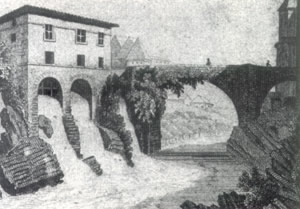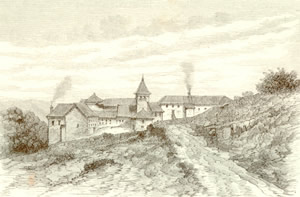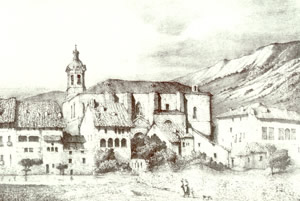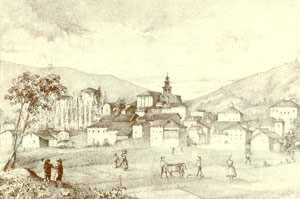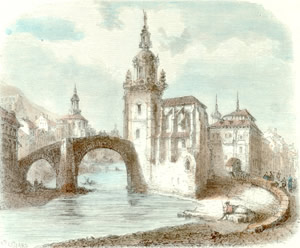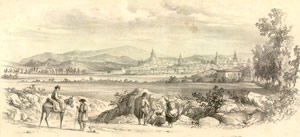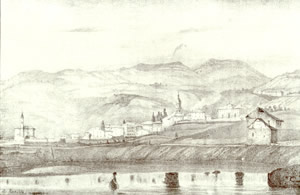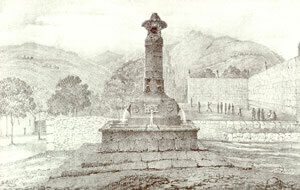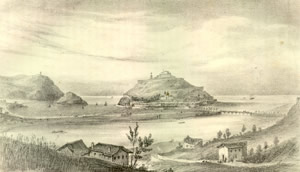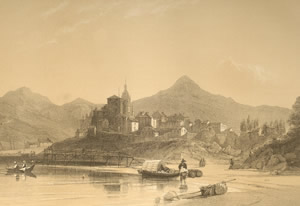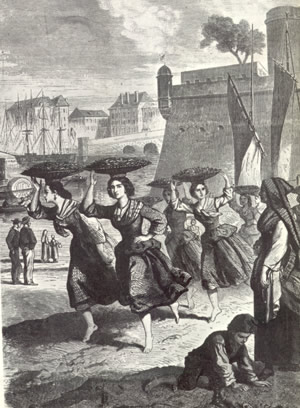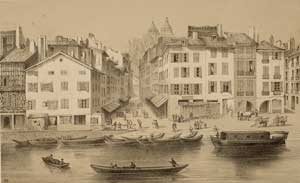12. FASCICLE
MAULEON
"La Soule is the only place where Basque theatre pieces are still performed. Here, they are called Pastorals (...) The actors are young and of both sexes, and the majority are illiterate. (.) The plays are performed in the open air, in Mauleón, the capital of the region, usually in the city's principal throughway, a shady avenue lined by high lime trees. The play is partly sung and partly recited. Entrance is free and foreigners, towards whom the locals are generally very attentive, are invited to take the front seats."
11. FASCICLE
RONCESVALLES
"I visited Roncesvalles to see the relics of Roland and the battlefield that appears so often in song. Neither was worth the gruelling journey. The battlefield is a plain stretching between the abbey and the Spanish town of Burguet, half an hour away. The remains of the fabulous knight are today kept, with no solemnity, in a high, firm vault in the church and consist of a large, broken stirrup, two maces, two pieces of the broken horn, and the golden crown, which he wore before the army during the battle."
10. FASCICLE
AZKOITIA - AZPEITIA
"Azkoitia and Azpeitia are the most vibrant image of Basque wellbeing. Separated only by around fifteen minutes, and joined by a stone path for pedestrians which runs along the banks of the River Urola, both towns seem to merge into one. Each has its own large parish church, built with luxury, and the style of the houses, the immaculate appearance of the streets and the pleasantly arranged walkways, all testify to the abundant means of subsistence enjoyed by its inhabitants. Nevertheless, neither is anything more than a small farming town, although certainly, they are located in the most fertile part of Gipuzkoa."
9. FASCICLE
GERNIKA
"All that can be seen is a fairly large oak, in no way picturesque, with a cracked trunk, twisted by the wind, and a few dry branches. An image, if you like, of the organisation of the country, which has held its own through many storms, although it has succumbed to some, and in more than one aspect has degenerated from its original form (.) The chapel, or to give it its proper name: la Iglesia juradera de Sta. María la antigua is built very close by, and is a long room whose seats, carved simply in wood and arranged in three staggered rows, can accommodate up to 300 people."
8. FASCICLE
BILBAO
"Although Bilbao is by far the most important and flourishing city, and in many aspects also the most charming of the Basque region, as far as my final objective is concerned, it is the least notable of all, since the continuous traffic of foreigners has done away with all native customs, which can now only be found in the countryside and the mountains, and even the language is highly impure and mixed with Spanish."
7. FASCICLE
VITORIA
"Vitoria, the capital of the province of Alava, can be considered a provincial city that is now flourishing thanks to trade and industrial activity. Life and wellbeing can be seen all over the city, and many great buildings have been recently constructed, including the market square, concluded in 1791. This square is quadrangular, built entirely from stone and is made up by 34 houses, of which the largest is the City Hall."
6. FASCICLE
BERGARA
"The Bergara Seminary, which as we know hosted, in former times, illustrious figures such as Proust, Chabanon and other famous scholars, was completely destroyed during the latest war with France, and work is now being carried out on its reestablishment.
The Seminary was founded by the Count of Peñaflorida, the promoter of the patriotic societies. (...) Since at this time he established the first thoughts for those societies, that later proved so useful, and then suddenly added the plan for a seminary."
5. FASCICLE
MARKINA
"In Markina I should mention a unique whim of nature. At one place, called Arretxinaga, there are three large crags - the whole thing standing around 40-50 feet high - two resting on their narrow side and being enormously wide at the top, standing a short distance from each other, and the third, being very large and heavy and resting on top of them, with the whole assembly threatening to come tumbling down at any moment, and only seeming to be held up by sheer balance. In other times, one could walk underneath the top crag; but since the whole thing has been classed as a miracle, an altar has now been built in the middle, alongside a chapel to Saint Michael."
4. FASCICLE
SAN SEBASTIÁN
"The next morning, upon our arrival we straight away visited the castle in order to enjoy from its height the view over the sea, a view one can never have enough of (...) Around both sides of the mountain upon which the fort is built, the sea forms small inlets, leaving between them only a narrow strip of land. On this strip, immediately at the foot of the mountain, stands the city. (.) It forms a regular square fortified on all sides. The streets are narrow, but the houses are tall and in places are built in a sumptuous manner "
3. FASCICLE
HONDARRIBIA - HENDAIA
"The inhabitants of Fuenterrabía and Andaye live naturally in daily communication with each other, belonging to the same town, speaking the same language, and on the border, with just the smallest differences in dialect, they really must be more closely united than any other border inhabitants in any other kingdom. It is one of the cruelties least taken into account in our wars, which have little to do with the interests of the people they involve, when such communities are brusquely sundered from one another, and a dividing wall of hate and enmity is erected between the tranquil inhabitants of friendly towns, counter to both their interests and their inclinations. "
2. FASCICLE
SAN JUAN DE LUZ
"Here I most admired the sardineras or sardine sellers whom I met on the road to San Juan de Luz. It is an amusing spectacle, when one sees coming out from behind a hill five or six, or sometimes as many as ten or even twenty female figures, all in a line, mostly tall and thin, with large, round, covered baskets of fish balancing freely on their heads. The women walk straight and erect, almost without moving their bodies and each one is in a hurry to be the first to cry their wares in Bayonne."
1. FASCICLE
BAIONA
"The city is small and has narrow streets, but the houses are pretty and altogether the place has a homely aspect. At the docks and in many streets there are arcades underneath the houses, and in them, as in the flat roofs and the many mules that one sees wandering here and there, one can note the proximity to Spain."
